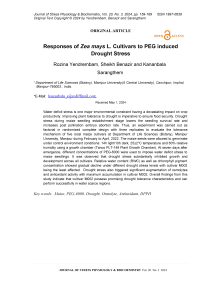Responses of Zea mays L. cultivars to peg induced drought stress
Автор: Yendrembam Rozina, Benazir Sheikh, Sarangthem Kananbala
Журнал: Журнал стресс-физиологии и биохимии @jspb
Статья в выпуске: 3 т.20, 2024 года.
Бесплатный доступ
Water deficit stress is one major environmental constraint having a devastating impact on crop productivity. Improving plant tolerance to drought is imperative to ensure food security. Drought stress during maize seedling establishment stage lowers the seedling survival rate and increases post pollination embryo abortion rate. Thus, an experiment was carried out as factorial in randomized complete design with three replicates to evaluate the tolerance mechanism of five local maize cultivars at Department of Life Sciences (Botany), Manipur University, Manipur during February to April, 2022. The maize seeds were allowed to germinate under control environment conditions: 14h light/10h dark, 25±2oC temperature and 60% relative humidity using a growth chamber (Tanco PLT-149 Plant Growth Chamber). At seven days after emergence, different concentrations of PEG-6000 were used to impose water deficit stress to maize seedlings. It was observed that drought stress substantially inhibited growth and development across all cultivars. Relative water content (RWC) as well as chlorophyll pigment concentration showed gradual decline under different drought stress levels with cultivar M002 being the least affected. Drought stress also triggered significant augmentation of osmolytes and antioxidant activity with maximum accumulation in cultivar M002. Overall findings from this study indicate that cultivar M002 possess promising drought tolerance characteristics and can perform successfully in water scarce regions.
Maize, peg-6000, drought, osmolyte, antioxidant, dpph
Короткий адрес: https://sciup.org/143182802
IDR: 143182802
Текст научной статьи Responses of Zea mays L. cultivars to peg induced drought stress
With the changing environmental condition, cultivated crop plants often encounter different abiotic stress during their growth and development. Drought stress is responsible for reduction of nearly 50% of world agronomic production (Lamaoui et al., 2018). As per FAO estimation, water scarcity accounts for a loss of USD 29 billion to agriculture in developing countries from 2005-2015 (FAO, 2021). Hence, concrete efforts towards development of high yielding, abiotic stress tolerant crop variety is critical to ensure food security. To achieve this, understanding crop tolerance and response to drought stress is imperative.
Severe drought during seedling stage cause visible leaf curling and stunted growth in Maize plants (Effendi et al., 2019). Despite seedling establishment stage being one of the most vulnerable growth stages, previous studies have proven that drought stress during this initial growth phase of plant life cycle can substantially improve tolerance to water scarcity in later growth stages (Auler et al., 2021). Several germination and seedling growth indices are therefore used frequently as basis for screening tolerant crop varieties (Queiroz et al., 2019). Hence, identifying and selecting drought tolerant cultivar during seedling establishment stage can help improve crop yield ( u et al., 2022).
PEG-6000, a non-ionic water soluble polymer extensively used to stimulate drought stress in plant was utilised to induce varying degree of drought to the germinating seedlings. This study explores the relative significance of osmolyte accumulation and antioxidant activity in maize seedling subjected to PEG induced drought stress. It aims to provide a better understanding and highlight the impact of drought stress on maize seedling establishment, recognising that the seedling stage in maize is particularly sensitive to drought stress and improving the mechanism of seedling stage drought tolerance for better crop establishment is the main target for maize drought resistant breeders.
MATERIALS AND METHODS
Relative Water Content elative water content ( WC) was determined following the method of Khaleghi et al. (2019). WC% was calculated according to Turner (1981) using the formula:
WC% = Freshweight-Dryweight Turgid weight -Dry weight x 100
Chlorophyll Content
Chlorophyll content of fresh maize leaves was determined according to the method by Lichtenthaler and Wellburn (1983). Chlorophyll a, chlorophyll b and total chlorophyll content were calculated as described by Arnon (1949).
Proline determination
0.2g fresh leaf sample was used to estimate proline content using ninhydrin reagent according to the method of Bates et al. (1973).
Total Phenolics
Khanam et al. (2012) method for phenol estimation using folin-ciocalteau reagent was used to quantify total phenol content in fresh maize leaves.
Total Soluble Sugar
Anthrone method was used to estimate the total soluble sugar content in leaves of maize seedling exposed to drought stress. Total sugar content was estimated from glucose standard curve.
Soluble Protein and Amino Acid
Soluble protein content in leaves for each treatment was estimated according to method by Lowry et al. (1951) and amino acid content was assessed in fresh leaf sample using the method by Yemm and Cocking (1955).
DPPH assay
The DPPH radicle scavenging activity was evaluated using the method described by Hatano et al. (1988). Final capacity to scavenge DPPH radicle was calculated using the formula by Son and Lewis (2002).
adicle Scavenging Assay ( SA) % = Ao - A 1 X 100 Ao
Where A0 is absorbance of the control reaction and A1 is absorbance of the sample at 517nm.
Determination of antioxidant activity
To determine the antioxidant enzyme activities (SOD, POD and CAT) in maize leaf, enzymatic extract was prepared using 0.5 g of fresh leaf sample in 5 ml of 50 mM potassium phosphate buffer (pH 7.8) under ice cold condition. The homogenate was centrifuged at 10000 x g for 30 min at 4oC. The resulting supernatant was collected and used as crude extract.
SOD activity was assayed according to Tang et al. (2010) by measuring the enzyme ability to inhibit photochemical reduction of nitro blue tetrazolium (NBT).
POD activity was determined according to Upadhyaya et al. (1985). One POD unit (U) was defined as the change of 0.01 OD per min at 37oC under the assay condition.
For CAT activity, 0.2ml enzyme extract was added to an assaying mixture containing 2ml of 50mM phosphate buffer (pH 7.5) and 1ml of hydrogen peroxide. Change in absorbance at 240 nm per min was recorded.
All data collected were statistically analysed using SPSS 20.0. The mean value of three replicates and standard error were determined using LSD-Duncan test at p≤0.05.
RESULTS
In the present study, five maize cultivars with diverse genetic backgrounds were evaluated for their morphological, physiological and biochemical response to osmotic stress induced using different concentrations of PEG 6000.
Impact of drought on plant morphological characteristics
Impact of drought on Relative Water Content (RWC)
eduction in WC of plant leaves is a primary physiological response to drought stress. Table 2 data shows the effect of drought stress on WC for all five maize cultivars. When compared to control, drought induction caused significant reduction in WC and lowest WC % was recorded under the 30% PEG treatment. Among the cultivars, most significant decline in WC was observed in cultivar M003 followed by M004.
Effect of drought on photosynthetic pigment content
Chlorophyll concentration is reduced when plants are exposed to abiotic stress as a result of increased oxidative stress and photo oxidation of chlorophyll pigments (Allakhverdiev 2020). To understand the extent of drought impact on photosynthetic attributes, chlorophyll a, b and total chlorophyll content were measured for all the tested cultivars. It was observed that PEG induced drought stress resulted in gradual decline of chlorophyll content in maize cultivars although no significant difference (p≤0.05) was observed across all treatment levels. Among the cultivars, it was observed that M002 showed the least reduction in chlorophyll content (Table 2).
Osmolyte Accumulation under drought stress
indicating that M002 might perform well under drought condition.
DPPH radicle scavenging assay
The DPPH radicle scavenging assay was evaluated in order to estimate the antioxidant activity of maize leaf extract under induced drought stress. Under control (0MPa) and -0.15MPa osmotic potential, rise in DPPH scavenging activity of the cultivars showed no significant difference (p≤ 0.05) (Fig 2). However, a sudden spike in antioxidant activity in all the cultivars was observed under -0.49 MPa and -1.03 MPa osmotic potential, the highest scavenging activity was recorded in M002 and M005.
Table 1. List of local maize cultivars used in the study
|
Cultivars |
Local Name |
|
M001(W) |
Chujak Angouba |
|
M002(V) |
Chujak Arangba |
|
M003( ) |
Chujak Angangba |
|
M004(B) |
Chujak Amuba |
|
M005(N) |
Nepali Chujak |
Table 2. Data represents mean of three replicates ± SE. Values followed by similar letters within a column are not significantly different at p≤0.05.
|
Maize Cultivar |
PEG Treatment |
Radicle Length (cm) |
Plumule Length (cm) |
Seedling Length (cm) |
RWC (%) |
Chl A (mg/gFW) |
Chl B (mg/gFW) |
Total Chl (mg/gFW) |
|
M001 (W) |
0MPa |
6.5±1.1de |
14.67±0.89b |
22.67±1.13cd |
83.19±0.09b |
0.51±0.03abc |
0.59±0.05a |
1.06±0.08ab |
|
-0.15MPa |
6.7±2.6de |
12.16±0.23c |
19.27±0.68de |
74.52±0.28e |
0.45±0.03bcde |
0.31±0.05bcd |
0.77±0.08cdef |
|
|
-0.49MPa |
7.1±0.9cd |
7.5±1.15ef |
14.2±2.13ghi |
47.17±0.13l |
0.33±0.03ghij |
0.28±0.02bcd |
0.64±0.12efgh |
|
|
-1.03MPa |
8±2.2bc |
2.26±1.03i |
8.73±0.3k |
46.39±0.79l |
0.26±0.03jk |
0.25±0.004bc |
0.5±0.01hi |
|
|
Mean |
7.08 |
9.15 |
16.22 |
62.82 |
0.39 |
0.36 |
0.74 |
|
|
M002 (V) |
0MPa |
8.4±2.1bcd |
17.96±0.57a |
29.07±0.68a |
79.13±0.46d |
0.59±0.02a |
0.64±0.02a |
1.23±0.01a |
|
-0.15MPa |
9.4±0.8abc |
16.13±0.45ab |
26.5±1.81ab |
70.6±0.25f |
0.43±0.04cdef |
0.53±0.04a |
0.81±0.07cde |
|
|
-0.49MPa |
10.4±2.8ab |
15.76±2.4b |
25.17±1.79bc |
65.33±0.35h |
0.36±0.01efgh |
0.33±0.07bc |
0.72±014defg |
|
|
-1.03MPa |
11.1±1.2a |
9.36±3.3de |
17.67±2.97efg |
62.41±0.38i |
0.36±0.05efgh |
0.29±0.04bcd |
0.58±0.06efgh |
|
|
Mean |
9.83 |
14.8 |
24.6 |
69.36 |
0.44 |
0.45 |
0.84 |
|
|
M003 (R) |
0MPa |
5.8±0.49e |
15.2±0.1b |
24.73±0.73bc |
88.55±0.35a |
0.4±0.05defg |
0.51±0.02a |
0.97±0.07bc |
|
-0.15MPa |
6±0.7de |
10.73±0.8cd |
18.3±0.7ef |
55.03±0.71g |
0.37±0.04efgh |
0.36±0.05b |
0.61±0.004efg |
|
|
-0.49MPa |
8.6±0.7cde |
7.86±1.45ef |
13.87±0.97hij |
67.64±0.54j |
0.27±0.01ijk |
0.29±0.02bcd |
0.63±0.03efgh |
|
|
-1.03MPa |
9.3±1.2abc |
2.5±0.62i |
7.77±0.29k |
36.08±0.34n |
0.25±0.02k |
0.18±0.01d |
0.53±0.05ghi |
|
|
Mean |
7.4 |
9.07 |
16.17 |
61.83 |
0.32 |
0.34 |
0.69 |
|
|
M004 (B) |
0MPa |
6±1.5de |
10.06±1.17cd |
16.43±1.46efgh |
83.3±0.61b |
0.48±0.02bcd |
0.57±0.03a |
1.05±0.04ab |
|
-0.15MPa |
5.8±0.6de |
7.96±1.33ef |
13.8±0.53hij |
70.9±0.12f |
0.35±0.01efgh |
0.33±0.04bc |
0.76±0.12cdef |
|
|
-0.49MPa |
5.4±1.2e |
5.43±0.35gh |
10.2±0.4jk |
47.84±0.22l |
0.31±0.05hij |
0.23±0.02bcd |
0.63±0.04efgh |
|
|
-1.03MPa |
4.8±0.45f |
2.76±0.45i |
8.17±0.9k |
40.08±0.13m |
0.27±0.02ijk |
0.19±0.01cd |
0.44±0.03i |
|
|
Mean |
5.5 |
6.55 |
12.15 |
60.53 |
0.35 |
0.33 |
0.72 |
|
|
M005 (N) |
0MPa |
8.1±0.36bcd |
10.43±0.46cd |
18.53±0.3ef |
80.68±0.47c |
0.54±0.03ab |
0.52±0.05a |
1.1±0.02ab |
|
-0.15MPa |
8.3±1.2bcd |
7.03±0.32fg |
15.37±0.5fgh |
66.85±0.3g |
0.45±0.03bcde |
0.36±0.09b |
0.88±0.03bcd |
|
|
-0.49MPa |
5.4±1.1ef |
5.13±0.57gh |
10.5±0.76ijk |
63.97±1.4h |
0.36±0.03efgh |
0.36±0.07b |
0.68±0.09defg |
|
|
-1.03MPa |
4.3±0.4f |
3.63±0.23hi |
7.97±0.12k |
52.07±0.32k |
0.34±0.02fghi |
0.3±0.03bcd |
0.55±0.07fgh |
|
|
Mean |
6.53 |
6.56 |
13.09 |
65.89 |
0.42 |
0.39 |
0.8 |
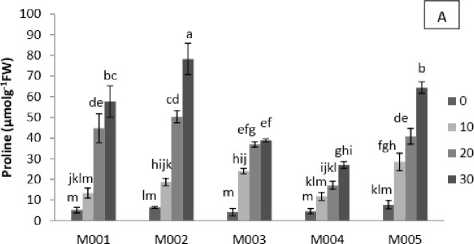
Cultivars
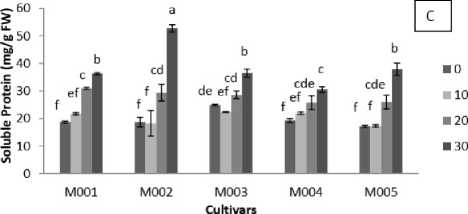
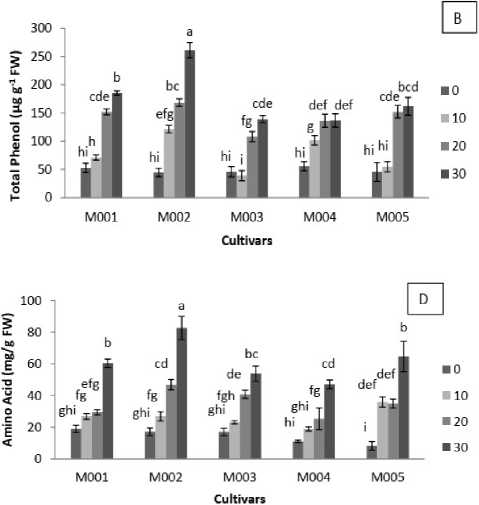
Figure 1. Effect of drought on ( A ) proline, ( B ) total phenol, ( C ) soluble protein, ( D ) amino acid, ( E ) total soluble sugar. Vertical bars indicate mean ± SE of three replicates. Different letters indicate significant difference at p≤0.05.
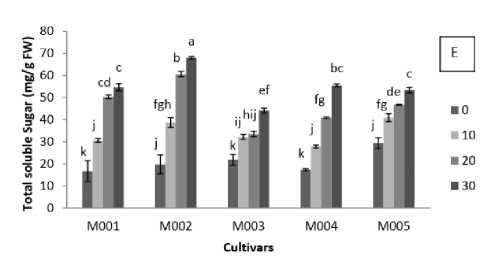
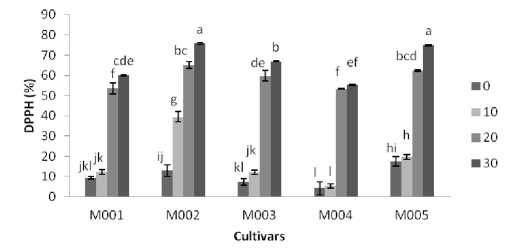
Figure 2. Effect of drought on DPPH radicle scavenging activity of five maize cultivars. Vertical bars indicate mean ± SE of three replicates. Different letters indicate significant difference at p≤0.05.


Figure 3. Effect of drought on (A) SOD, (B) POD, (C) CAT activities of five maize cultivars. Vertical bars indicate mean ± SE of three replicates. Different letters indicate significant difference at p≤0.05.

Figure 4. Photographs comparing the performance of different maize cultivars at 7 DAT under control (0MPa) condition. W=M001, V=M002, =M003, B=M004 and N=M005.
а ИЙДЯ
Figure 5. Photographs comparing the performance of different maize cultivars at 7 DAT under 10% PEG treatment (0.15MPa). W=M001, V=M002, =M003, B=M004 and N=M005.
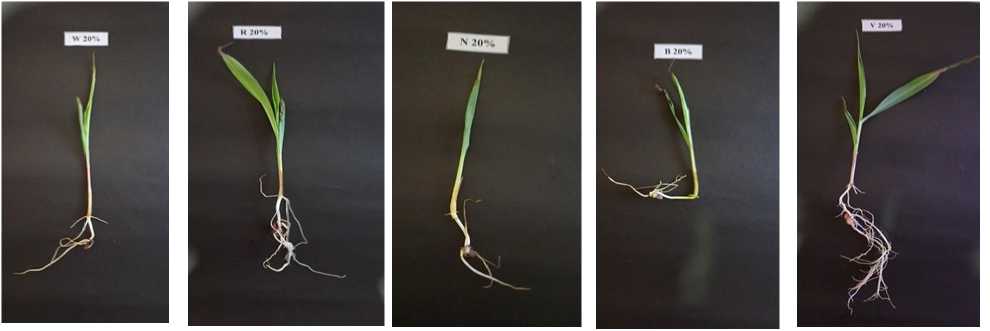
Figure 6. Photographs comparing the performance of different maize cultivars at 7 DAT under 20% PEG treatment (0.49MPa). W=M001, V=M002, =M003, B=M004 and N=M005.

Figure 7. Photographs comparing the performance of different maize cultivars at 7 DAT under 30% PEG treatment (1.03MPa). W=M001, V=M002, =M003, B=M004 and N=M005.
Impact of drought stress on antioxidant activity
Drought stress induces significant (p ≤ 0.05) variation in antioxidant activity among the five maize cultivars. A gradual rise in SOD activity was observed in all cultivars with increase in severity of drought and maximum value was recorded in cultivar M002 (Fig 3A). Similarly, a significant rise in POD and CAT activities was also evident across all the cultivars (Fig 3B, 3C). Maximum activities of POD and CAT were recorded in M002 and M005 under -1.03MPa treatment.
DISCUSSION
Prevalence of drought and its detrimental impacts on plants necessitates studies on exploring plant drought tolerance mechanisms to mitigate significant yield losses under water stress (Singh et al. 2014). In this study, five maize cultivars with diverse genetic backgrounds were evaluated for their morphological, physiological and biochemical response to osmotic stress induced using different concentrations of PEG 6000. Although drought significantly reduced shoot growth in all cultivars, radicle length of most cultivar increases under drought except for cultivar M004 and M005. As mentioned by Leishman and Westoby, 1994, ability to extend radicle length is an important trait for selection of drought resistant cultivars. In this study, M002 cultivar with highest root extension can be considered as a tolerant cultivar.
Conspicuous decline in leaf water content was observed across all cultivars under drought stress. However, the negative impact of drought was more pronounced in sensitive cultivars compared to tolerant cultivars. The observed reduction in WC of maize seedling agrees with previous findings reported by Nayyar and Gupta (2006).
Drought stress displayed differential influence on chlorophyll content in leaves of all five maize cultivars. Notably, different cultivars exhibited distinct sensitivity to PEG induced drought stress. Decline in chlorophyll level under drought stress have been reported in other species such as wheat and rice. According to Herbinger et al. (2002), the observed degradation of light absorbing pigments under drought stress might contribute towards effective avoidance of OS production in plants.
Plants generally accumulate osmolytes such as proline, soluble sugar, protein, amino acid and phenol chiefly in cytoplasm in response to drought stress. This enable plants to effectively scavenge OS, maintain optimum water potential and protect cellular components from lipid peroxidation ( aza et al. 2019).
Proline accumulation in plants has been extensively studied and reported to be an adaptive response to osmotic stress (Hare et al. 2002). A significant (p<0.05) rise in proline concentration was observed in all the maize cultivars with increase in drought level. This observation is in accordance with previous reports in other plants such as Arabidopsis thaliana (Sperdouli and Moustakas 2012), Capsicum annuum (Anjum et al. 2012) and Oryza sativa (Dien et al. 2019). Proline not only regulates osmotic potential under stress condition but also functions as scavenger for free radicles and protects plant leaves against lipid peroxidation (Gill and Tuteja 2010). Highest spike in proline accumulation was recorded under -1.03MPa osmotic potential this might have helped in effective recovery of plants after stress.
Analysis of phenol content in this study showed a significant increase in total phenol content across all cultivars which is in alignment with reports made earlier in this context. Saad Allah et al. (2022) and Sarker and Oba (2018) reported a similar progressive increase in total phenol content in plants under drought stress.
It was observed that the level of soluble sugar, protein and amino acid in all maize cultivars rise gradually with increase in drought level. Compatible solutes such as soluble sugar, protein and amino acid accumulate in plant tissue chiefly in cytoplasm in response to limited water availability signifying their role in improving osmotic adjustment, OS detoxification and cell membrane protection in plants under osmotic stress ( aza et al. 2019; eddy et al. 2004). Soluble sugar has been widely acknowledged as the main osmolyte contributing directly in mitigating oxidative damage in plants species (Dubey and Singh 1999). In the present study maize cultivars respond to drought stress with increased accumulation of soluble sugar which might have improved the OS scavenging potential in maize cultivars. Hence, it can be concluded that drought sensitivity of cultivars might be associated with lower level of soluble sugar accumulation since sugar starved plants have been reported to produce more OS (Couee 2006).
DPPH assay was carried out to evaluate the free radicle scavenging potential of the cultivars. Plants with higher radicle scavenging potential tend to perform better under unfavourable climatic conditions. In this study, a gradual rise in SA% was observed with increase in drought severity. The result indicates that there is a significant decrease in DPPH radicle due to rise in scavenging activity of antioxidants present in maize cultivars under drought stress.
Similarly, an enhanced accumulation of enzymatic antioxidants such as SOD, POD and CAT in plants under oxidative stress act as powerful defence shield against oxidative damage. High antioxidant content in plant leaves confer significant drought tolerance (Aslam et al. 2015). In the present study, drought treatment significantly increased antioxidant activity in all maize cultivars. It is evident that the cultivars showed varied response to induced drought stress with cultivar M002 showing the highest antioxidant activities while cultivar M003 showed the least antioxidant activity.
CONCLUSION
Drought significantly impacted on all measured parameters across all osmotic stress levels. In the present experiment, cultivar M002 performed well under drought stress in terms of growth, development and biochemical parameters. Compared to rest of the cultivars, M002 accumulated abundant osmolytes along with enhanced antioxidant activities even under severe drought stress (-1.03MPa) condition. Therefore, it can be concluded that cultivar M002 is superior in terms of drought tolerance and after further field level performance analysis, this cultivar could be advised for large scale cultivation in drought prone areas.
ACKNOWLEDGMENTS
The authors are grateful to the Department of Life Sciences (Botany), Manipur University for providing necessary requirements for conducting the experiments.
CONFLICTS OF INTEREST
The authors declare that they have no potential conflicts of interest.
Список литературы Responses of Zea mays L. cultivars to peg induced drought stress
- Allakhverdiev, S.I. (2020). "Optimising Photosynthesis for Environmental Fitness." Funct. Plant Biol.47.
- Anjum, S.A., Farooq, M., Xie, X., Liu, X., and Ijaz, M.F. (2012). "Antioxidant defense system and proline accumulation enables hot pepper to perform better under drought." Sci. Hortic. 140, 66-73.
- Arnon, D.I. (1949) "Copper enzymes in isolated chloroplasts. Polyphenol oxidase in Beta vulgaris." Plant Physiol. 24: 1-15.
- Aslam, M., Maqbool, M.A. and Cengiz, R. (2015) "Drought stress in maize (Zea mays L.)." Cham: Springer International Publishing AG.
- Auler, P.A., Souza, G.M., da Silva Engela, M.R.G., do Amaral, M.N., Rossatto, T., da Silva, M.G.Z., Furlan, C.M., Maserti, B. and Braga, E.J.B. (2021) Stress memory of physiological, biochemical and metabolomic responses in two different rice genotypes under drought stress: The scale matters. Plant Sci., 311, 110994. Bates, L.S., Walden, R.P. and Teare, I.D. (1973) "Rapid reactive oxygen species balance and responses to oxidative stress in plants." J. Exp. Bot. 57, 449459.
- Dien, D. C., Toshihiro, M., and Takeo, Y. (2019). "Effect of various drought stresses and subsequent recovery on proline, total soluble sugar and starch metabolisms in Rice (Oryza sativa L.) varieties." Plant Production Science Vol. 22, No. 4, 530-545.
- Dubey, R.S., and Singh, A.K. (1999). "Salinity Induces Accumulation of Soluble Sugars and Alters the Activity of Sugar Metabolising Enzymes in Rice Plants." Biologia Plantarum 42(2):233-239. doi: 10.1023/a:1002160618700.
- Effendi, R., Priyanto, S.B., Aqil, M. and Azrai, M. (2019) Drought adaptation level of maize genotypes based on leaf rolling, temperature, relative moisture content, and grain yield parameters. IOP Conf. Ser. Earth Environ. Sci., 270, 012016.
- FAO (2021). The Impact of Disasters and Crises on Agriculture and Food Security. Rome: Food and agriculture organization of the United Nations. 2021.
- Gill, S.S., and Tuteja, N. (2010). "Reactive oxygen species and antioxidant machinery in abiotic stress tolerance in crop plants." Plant Physiol. Bioch. 48, 909-930.
- Hare, P.D., Cress, W.A., and Staden, J.V. (2002). "Dissecting the roles of osmolyte accumulation during stress." Plant, Cell & Environment 21, 535553.
- Hatano, T., Kagawa, H., Yasuhara, T. and Okuda, T. (1988) "Two new flavonoids and other constituents in Licorice root: their relative astringency and radical scavenging effects." Chem. Phar. Bull. 36, pp. 2090-2097.
- Herbinger, K., Tausz, M., Wonisch, A., Soja, G., Sorger, A. and Grill, D. (2002) "Complex interactive effects of drought and ozone stress on the antioxidant defence systems of two wheat cultivars." Plant Physiol. Biochem. 40: 691-696.
- Khaleghi, A., Rohangiz, N., Cecilia, B., Bianca, E. M., Seyed, A. S. and Mesbah, B. (2019) "Morphological, physiochemical and antioxidant responses of Maclura pomifera to drought stress." determination of free proline for water studies." Plant and Soil 39: 205-208. Couee, I. (2006). "Involvement of soluble sugars in Scientific Reports 9:19250.
- Khanam, U.K.S., Oba, S., Yanase, E. and Murakami, Y. (2012) "Phenolic acids, flavonoids and total antioxidant capacity of selected leafy vegetables."
- (2018). "Heat and drought stresses in crops and approaches for their mitigation." Front. Chem. 6:26. doi: 10.3389/fchem.2018.00026
- Leishman MR, Westoby M (1994). "The role of seed size in seedling establishment in dry soil conditions -experimental evidence from semi-arid species. "J. Ecol., 82, 249-258. doi:10.2307/2261293
- Lichtenthaler, H.K. and Wellburn, A.R. (1983) "Determinations of total carotenoids and chlorophylls a and b of leaf extracts in different solvents." Biochemical Society Transactions 591592.
- Lowry, O.H., Rosebrough, N.J., Farr, A.L. and Randall, R.J. (1951) J. Biol. Chem 193: 265.
- Michel, B.E. and Kaufmann, M.R. (1973) "The osmotic potential of polyethylene glycol 6000." Plant Physiol. 51: 914-916.
- Nayyar, H. and Gupta, D. (2006) "Differential sensitivity of C3 and C4 plants to water deficit stress: association with oxidative stress and antioxidants." Environmental and Experimental Botany 58, pp. 106-113.
- Queiroz, M.S., Oliveira, C.E., Steiner, F., Zuffo, A.M., Zoz, T., Vendruscolo, E.P., Silva, M.V., Mello, B.F., Cabral, R.C. and Menis, F.T. (2019) "Drought stresses on seed germination and early growth of maize and sorghum." J Agric Sci. 11(2):310-318
- Raza, A., Mehmood, S.S., Tabassum, J. and Batool, R. (2019) "Targeting plant hormones to develop abiotic stress resistance in Wheat production in changing environments." Springer: Berlin/Heidelberg, Germany pp. 557-577.
- (2004). "Drought-induced responses of photosynthesis and antioxidant metabolism in higher plants." J. Plant Physiol. 161, 1189-1202.
- Ru, C., Hu, X., Chen, D., Wang, W.and Song, T. J. E. (2022) "Heat and drought priming induce tolerance to subsequent heat and drought stress by regulating leaf photosynthesis, root morphology, and antioxidant defense in maize seedlings." Environ. Exp. Bot. 202, 105010.
- Saad-Allah, K.M., Nessem, A.A., Ebrahim, M.K.H., and Gad, D. (2022). "Evaluation of Drought Tolerance of Five Maize Genotypes by Virtue of Physiological and Molecular Responses." Agronomy 12, 59.
- Sarker, U. and Oba, S. (2018). "Drought stress enhances nutritional and bioactive compounds, phenolic acids and antioxidant capacity of Amaranthus leafy vegetable." BMC Plant Biology 18:258
- Singh, R., Pandey, N., Naskar, J. and Shirke, P.A. (2014) "Physiological performance and differential expression profiling of genes associated with drought tolerance in contrasting varieties of two Gossypium species." Protoplasma 252, 423-438.
- Son, S. and Lewis, B.A. (2002) "Free radical scavenging and antioxidative activity of caffeic acid amide and ester analogues: structure-activity relationship." J. Agric. Food Chem. 50, 468-472.
- Sperdouli, I., and Moustakas, M. (2012). "Interaction of Proline, Sugars, and Anthocyanins during Photosynthetic Acclimation of Arabidopsis thaliana to Drought Stress." Journal of Plant Physiology 169, 577-585.
- Tang, B., Xu, S., Zou, X., Zheng, Y. and Qiu, F. (2010) "Changes of antioxidative enzymes and lipid peroxidation in leaves and roots of water logging-tolerant and water logging-sensitive maize genotypes at seedling stage." Agric. Sci. China 9, 651-661.
- Turner, N. C. (1981) "Techniques and experimental approaches for the measurement of plant water status." Plant Soil 58, 339-366.
- Upadhyaya, A., Sankhla, D., Davis, T.D., Sankhla, N. and Smith, B.N. (1985) "Effect of paclobutrazol on the activities of some enzymes of activated oxygen metabolism and lipid peroxidation in senescing soybean leaves." J. Plant Physiol. 121, 453-461.

